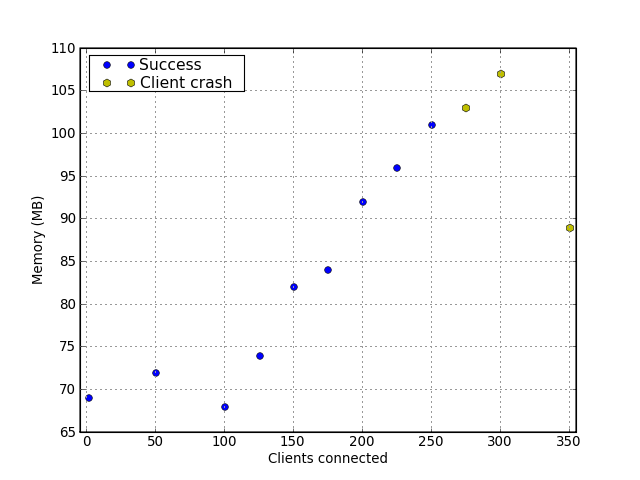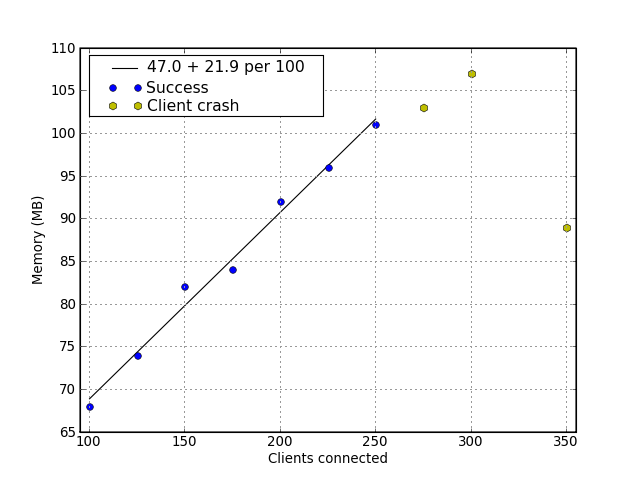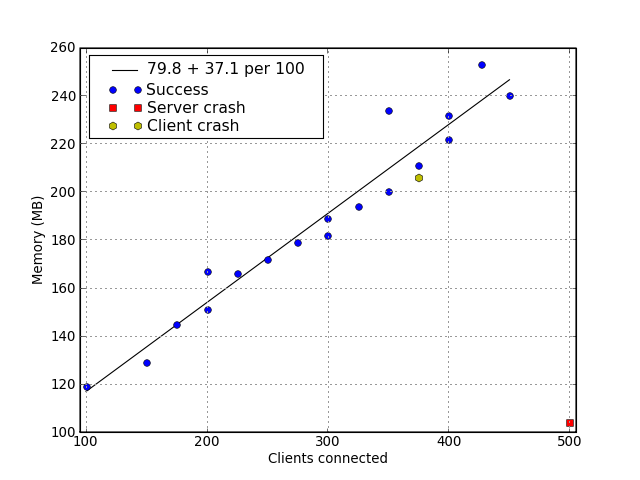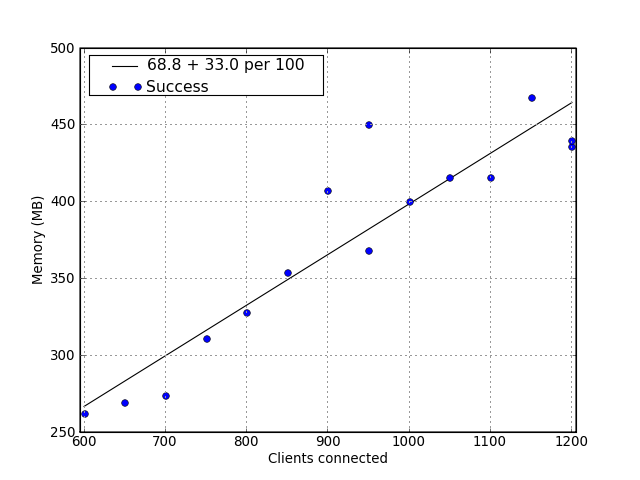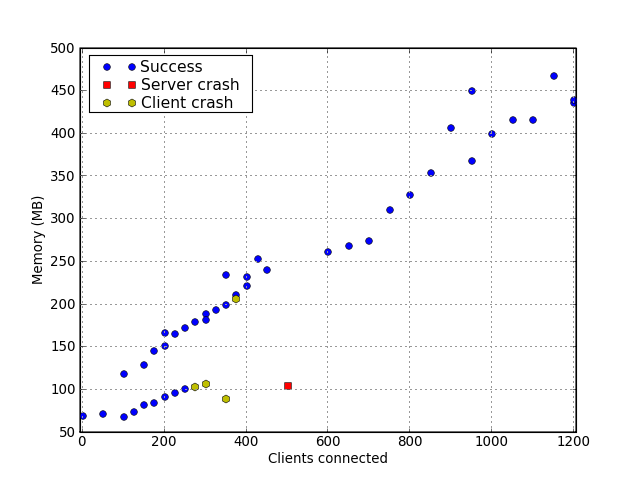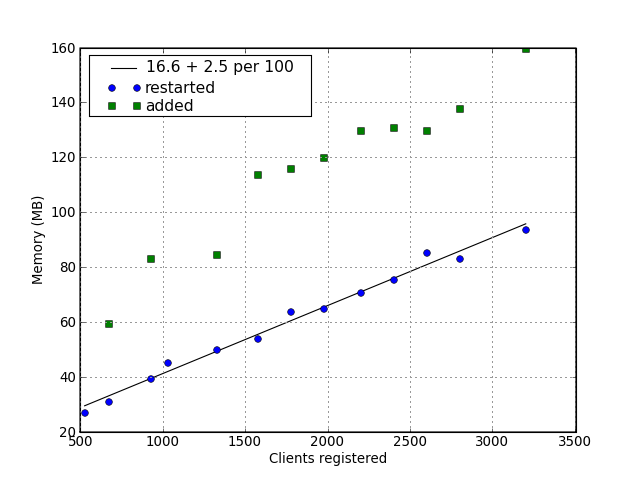Ejabberd resource tests
Contents
The purpose of these tests
The XS school server is going to be installed in schools with more than 3000 students. In these large schools, ejabberd is crucial for functional collaboration. If all the students are using their laptops at once, ejabberd might be considerably stressed. These tests were run to find out how it runs in various circumstances.
Set up
The cpu of the server running ejabberd reports itself as "Intel(R) Pentium(R) Dual CPU E2180 @ 2.00GHz". The server has 1 GB ram and 2 GB swap.
The client load was provided by [http://dev.laptop.org/git?p=users/guillaume/hyperactivity/.git hyperactivity]. Each client was limited in number of connections it could maintain (by, it seems, Telepathy Gabble or dbus), so several machines were used in parallel. Four of the client machines were fairly recent commodity desktops/laptops -- one was the server itself -- and four were XO laptops. The big machines were connected via wired ethernet and could provide up to 250 connections each, while the XOs were using mesh and providing 50 clients each. From time to time hyperactivity would fail with these numbers and have to be restarted.
It took time to work out these limits, so the tests were initially tentative. The graphs below, the script that made them, longer versions of these notes, and perhaps unrelated stuff can be found at [1].
In order to test, I had to add the line
{registration_timeout, infinity}.
to /etc/ejabberd/ejabberd.cfg (including the full-stop).
First try: 523 accounts, single client machine
Mostly by accident, 523 ejabberd accounts were created. These accounts were used in 25 connection increments, connecting from just one client.
The memory numbers were gathered after the load had settled after a few minutes. Peak use was perhaps 10% higher.
Clients interval mem load avg client OK server OK --------------------------------------------------------------- 1 15 69 0.01 True True 50 15 72 0.02 True True 100 15 68 0.12 True True 125 15 74 0.08 True True 150 15 82 0.22 True True 175 15 84 0.24 True True 200 15 92 0.21 True True 225 15 96 0.06 True True 250 15 101 0.13 True True 275 15 103 0.09 False True 300 15 107 - False True 350 15 89 - False True
Note: from 275 up the client crashed before the numbers had time to settle.
This is probably best viewed as a steady linear increase,
with the low numbers hidden by a noise floor. Seen like that, there
seems to be a memory footprint of 47MB + 22MB per 100 clients.
Extrapolating to 3000 clients would add to about 700 MB, though that
is a very long way to extrapolate.
Second try: 3200 accounts, multiple clients
I ran hyperactivity on several machines to get the following results.
# Tested with 3200 users and 15 second intervals from 3 clients (2 XOs # 50 each; toshiba laptop - up to 275). # # Clients secs mem load avg client OK server OK 100 15 119 0.12 True True 150 15 129 0.16 True True 175 15 145 0.38 True True 200 15 151 0.25 True True 225 15 166 0.31 True True 250 15 172 0.40 True True 275 15 179 0.43 True True 300 15 189 0.43 True True 325 15 194 0.51 True True 350 15 200 0.67 True True 375 15 206 0.60 False True #Starting 200 users from xs-devel (martin's dell core2 duo laptop) # then adding 2 XOs with 50 each # then steps of 25 from the toshiba 200 15 167 0.20 True True 300 15 182 0.20 True True 375 15 211 0.80 True True 400 15 222 0.77 True True #adding another XO # web interface is very slow to report these connections, # getting stuck first on 427 427 15 253 0.86 True True # stop all but 1 XO (now dell 200, toshiba 100, XO 50). 350 15 234 0.56 True True #restart 3 XOs, 1 at a time 400 15 232 0.88 True True 450 15 240 0.96 True True 500 15 104 1.02 True False # web interface dies at 500-15. mem drops to 89. # sharing works for new connections
However I tried it, ejabberd would always crash with around 500 connections. It turns out this was due to a system limit on the number of open files, which can be raised by editing /etc/security/limits.conf (see the next section).
This shows that memory usage is fairly well predicted as 80 MB + 37MB per 100 active clients. That would mean an ejabberd instance with 3000 active clients needs about 1200MB.
The load average jumps around a bit, but definitely goes up as clients are added.
Try 3: 3000ish clients; past the 500 connection barrier
Eventually I thought to increase the number of open files that ejabberd can use, which allowed it to maintain more than 500 connections. This can be done in a couple of ways: most properly by adding these lines to /etc/security/limits.conf:
ejabberd soft nofile 65535 ejabberd hard nofile 65535
or by putting this line in /etc/init.d/ejabberd:
start() {
+ ulimit -n 65535
echo -n $"Starting ejabberd: "
which shouldn't require a new login to take effect.
I started with about 2900 clients, but hyperactivity increased this as it created new clients. It got to around 3300. The number of inactive clients seems to have relatively little effect on ejabberd, so I'm ignoring this.
# Starting with 2926 registered users # open files set by ulimit to 65535 # # Clients secs mem load avg client OK server OK 600 15 262 0.75 True True 650 15 269 0.84 True True 700 15 274 1.12 True True 750 15 311 1.32 True True 800 15 328 1.66 True True 850 15 354 1.80 True True 900 15 407 1.83 True True 950 15 368 1.78 True True 950 15 450 1.78 True True 1000 15 400 1.80 True True 1050 15 416 2.06 True True 1100 15 416 2.01 True True 1150 15 468 2.04 True True 1200 15 436 2.07 True True # drop all but 200 clients, wait 5 minutes. # 200 15 371 0.63 True True 1200 15 440 1.89 True True # memory use was really jumpy. These numbers are approximately what # the system converged on over time. # (e.g. 1000 clients peaked over 500M, dropped to 390ish) # # After 800, clients sometimes dropped off.
1200 is about the limit that my test setup can get to (i.e. 4 * 250 + 4 * 50). ejabberd ran quite happily at that point, though the load averages suggest it would not have liked much more.
ejabberd peaked at 667.6MB, and went over 500 several times. These fleeting binges tended to follow the connection of new clients. As hyperactivity connects with unnatural speed, it would unfair to judge ejabberd on those numbers, but it does seem that ejabberd could do with 50% headroom over its long term average.
This set gives us 69MB + 33 per 100, or about 1070MB for 3000, and it suggests that 1.6 GB would accommodate surges. A faster processor is almost certainly necessary.
Here is a graph combining the last 2:
and here is one with them all, without the line (remember the lower set had a quite different number of accounts):
Memory use of inactive users
# Adding users, restarting to find the base load of registered inactive users. # # users after add after restart 523 - 27.2 670 59.5 31.1 924 83.4 39.4 1024 45.4 1324 84.7 50.0 1574 113.9 54.1 1774 116.0 64.1 1974 120.1 65.2 2200 130 71.0 2400 131 75.7 2600 130 85.3 2800 138 83.2 3200 160 93.7
This suggests the memory cost of registered inactive users is also linear, and relatively low at 25MB per thousand.
Issues
- Is pounding ejabberd every 15 seconds reasonable? A lighter load actually makes very little memory difference, but it probably saves CPU time.
